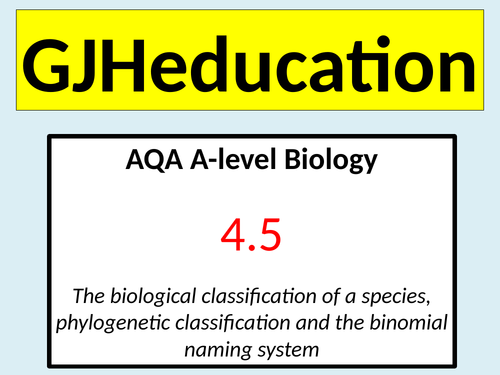



This engaging lesson covers the biological classification of a species, phylogenetic classification and the use of the binomial naming system. The PowerPoint and accompanying resources have been designed to cover point 4.5 of the AQA A-level Biology specification which is titled species and taxonomy.
The lesson begins by looking at the meaning of a population in Biology so that the term species can be introduced. A hinny, which is the hybrid offspring of a horse and a donkey, is used to explain how these two organisms must be members of different species because they are unable to produce fertile offspring. Although the art of courting might be lost on humans in the modern world, the marabou stork is used as an example to show how courtship behaviour is an essential precursor to successful mating in most organisms. Students are encouraged to discuss other examples of courtship behaviour, such as the release of pheromones and birdsong, so that their knowledge and understanding is broad.
Moving forwards, students will learn that species is the lowest taxon in the modern-day classification hierarchy. A quiz runs throughout the lesson and this particular round will engage the students whilst they learn the names of the other 7 taxa and the horse and the donkey from the earlier example are used to complete the hierarchy. Students will understand that the binomial naming system was introduced by Carl Linnaeus to provide a universal name for each species and they will be challenged to apply their knowledge by completing a hierarchy for a modern-day human, by spotting the correct name for an unfamiliar organism and finally by suggesting advantages of this system.
The final part of the lesson briefly looks at how advances in genome sequencing and the comparison of common biological molecules has allowed the relationships between organisms to be clarified.
This is a detailed lesson and it is estimated that it will take around 2 hours of A-level teaching time to cover the content and therefore this specification point.
Get this resource as part of a bundle and save up to 39%
A bundle is a package of resources grouped together to teach a particular topic, or a series of lessons, in one place.
Topic 4: Genetic information, variation and relationships between organisms (AQA A-level Biology)
Every one of the lessons included in this bundle is detailed, engaging and fully-resourced, and has been written to cover the content as detailed in topic 4 of the AQA A-level Biology specification. The wide range of activities will maintain engagement whilst supporting the explanations of the content to allow the students to build a deep understanding of genetic information, variation and relationships between organisms. The following 17 lessons covering the 7 sub-topics are included in this bundle: 4.1: DNA, genes and chromosomes * DNA in prokaryotes and eukaryotes * Genes 4.2: DNA and protein synthesis * Genome, proteome and the structure of RNA * Transcription and splicing * Translation 4.3: Genetic diversity can arise as a result of mutation or during meiosis * The genetic code * Gene mutations * Chromosome mutations * Meiosis 4.4: Genetic diversity and adaptation * Genetic diversity * Natural selection * Adaptations 4.5: Species and taxonomy * Species and taxonomy 4.6: Biodiversity within a community * Biodiversity within a community * Calculating an index of diversity * The balance between conservation and farming 4.7: Investigating diversity * Investigating diversity * Interpreting mean values and the standard deviation If you would like to sample the quality of the lessons in this bundle, then download the DNA in prokaryotes and eukaryotes, structure of RNA, gene mutations, natural selection and standard deviation lessons as these have been uploaded for free
Topics 4.4 - 4.7 (AQA A-level Biology)
These 7 lessons are highly detailed and are filled with a wide range of tasks that will engage the students whilst covering the following specification points in topics 4.4, 4.5, 4.6 and 4.7 of the AQA A-level Biology specification: 4.4 Genetic diversity as the number of different alleles of genes in a population and a factor enabling natural selection to occur The principles of natural selection in the evolution of populations Directional and stabilising selection Natural selection results in anatomical, physiological or behavioural adaptations 4.5 Two organisms belong to the same species if they are able to produce fertile offspring The taxonomic hierarchy comprising domain, kingdom, phylum, class, order, family, genus and species The use of the binomial name to identify species 4.6 Biodiversity can relate to a range of habitats Species richness Calculating an index of diversity 4.7 Investigating genetic diversity with, or between species, by comparing observable characteristics or nucleic acids and the structure of proteins Calculating and interpreting the mean and standard deviation If you download the natural selection and standard deviation lessons which have been shared for free then you will be able to see the quality of lessons included in this bundle
Something went wrong, please try again later.
Great resource - as good as your others!
Report this resourceto let us know if it violates our terms and conditions.
Our customer service team will review your report and will be in touch.